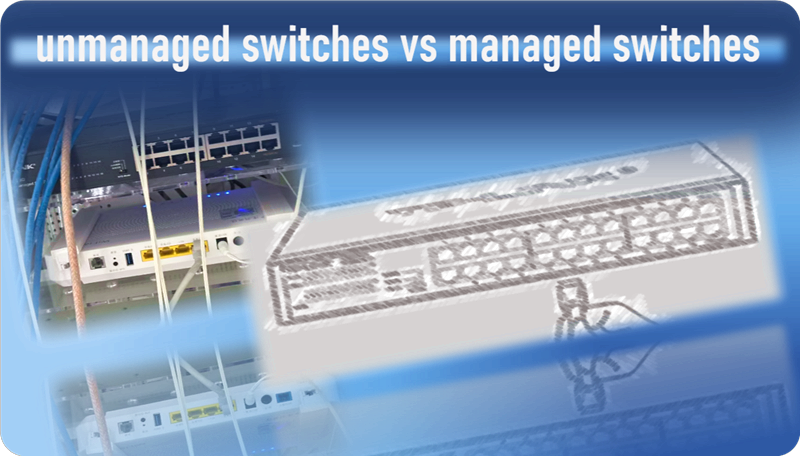Networking Device
Managed vs Unmanaged Switches: What’s the Difference?
A switch is actually similar to an electrical (optical) signal forwarding “switch”, which is a network device that provides a dedicated electrical signal path for any two network nodes connected to the switch. It is the core of a local area network, responsible for segmenting, interpreting, and filtering data packets before sending them directly to connected network devices. We all know that managed switches and unmanaged switches are the two most common types of switches. What are the differences between them? How should we choose which switch to use?
Table of contents
What is a managed switch?
The main task of a managed switch is to keep all network resources in good condition. It provides various network management methods, such as terminal-based control ports, Web management, network management software, etc, so that network administrators can monitor the working status and operation locally or remotely. Managed switch data will be configured through SNMP implementation, relaying configuration data to network engineers, which makes troubleshooting easier while improving uptime.
Features of a managed switch with full control and monitoring capabilities include:
- It can be utilized in a broader array of network structures, including Spanning Tree Protocol, ring, mesh, stacking, and aggregation, to increase redundancy and dependability.
- A multitude of security features are in place to supervise network access, identify potential attacks, and rectify any security breaches.
- The system can enhance the performance of devices and applications on the network through Quality of Service (QoS), which prioritizes traffic and groups device types with common services.
What is an unmanaged switch?
Unmanaged switches require no additional configuration to use. Once a user plugs into this type of switch, they immediately begin forwarding traffic.
Characteristics of unmanaged switches include:
- Applicability is limited to simple network topologies such as star and daisy chains.
- Ability to create and store MAC address tables, enabling better traffic management than using an Ethernet hub.
- There is no difference between the way switches handle multicast traffic and broadcast traffic, which can lead to a serious congestion problem known as broadcast storms (especially a problem with industrial IoT devices, which often rely on multicast traffic to execute device-related commands)
Managed vs. Unmanaged Switch: Key Differences
The following table lists the differences between various aspects of managed and unmanaged switches:
| Aspect | Managed Switches | Unmanaged Switches |
| Complexity | More complex setup and management | Plug-and-play simplicity |
| Configuration | Customizable configurations and settings | Customizable configurations and settings. Fixed configuration, no user changes |
| Scalability | Scalable with features like VLANs | Limited scalability for smaller setups |
| Network Monitoring | Advanced traffic monitoring and troubleshooting | Lacks network monitoring capabilities |
| Security | Offers advanced security functions (ACLs, MAC filtering and so on) | Basic security function |
| Remote Management | Supports remote configuration and monitoring | Lacks remote management capabilities |
| web interface | Provides a web interface for configuration | Simple web interface, or no |
| Redundancy | Offers redundancy to minimize downtime | No redundancy features |
| Bandwidth Allocation | Bandwidth allocation will be limited and can also be adjusted | Shared bandwidth, automatic allocation |
| Group Management Protocol (IGMP) | Usually supports IGMP to optimize network performance | Not supporting IGMP, unable to manage multicast traffic |
| Cost | Costs can be affordable, depending on the number of ports in the switch | Managed switches are more expensive, depending on the specific features, and there are personnel costs to consider |
| Application | Large/Government organization/Commercial Business | Home/Dormitory/Small Business |
| Installation | Done by Technicians | Done by Everyone |
Managed vs. Unmanaged Switch: How to choose the right switch?
Choosing the right switch is not as complicated as you think. Of course, you can consult both professional network administrators and network equipment sellers. However, I think your decision will be more suitable after considering the following factors.

1. Network size
If you need to use this device for a small office or home network and require simple operation, unmanaged switches will be sufficient.
However, managed switches are more suitable for medium to large organizations, especially those where high security and network monitoring are required, such as government agencies, universities, etc.
2. Network Requirements
Managed switches are the right choice when you have high requirements for network management, monitoring, and security.
On the contrary, if you do not demand a high number of network equipment features, lack experience in network management, and have a limited budget, an unmanaged switch will be more suitable.
3. Future scalability
If your network will be expanding in the future, unmanaged switches may not be able to meet the network requirements and may cause problems such as poor network performance. By selecting a managed switch, you can more easily accommodate future network expansion and technological updates.
4. Cost
Budget is also an important factor in deciding which switch you should choose. Managed switches are more expensive and require a good budget. Unmanaged switches allow you to solve your network equipment purchasing dilemma with a small budget.
Conclusion
Managed switches differ from unmanaged switches in different ways, and we hope this article has helped you understand the differences.
This article introduces the concepts and features of managed and unmanaged switches and compares them in the hope of helping you understand their differences. Based on your personal consideration of your network needs, you can choose a more suitable network device.
If you are still unsure which switch to choose, you can hire a network expert to help you.
You may also be interested in
- Layer 2 vs. Layer 3 Network Switches: Do you Know the Difference?
- How to choose an industrial Ethernet switch?
- Discover the Best Optical Transceivers for All Switches!







